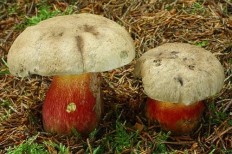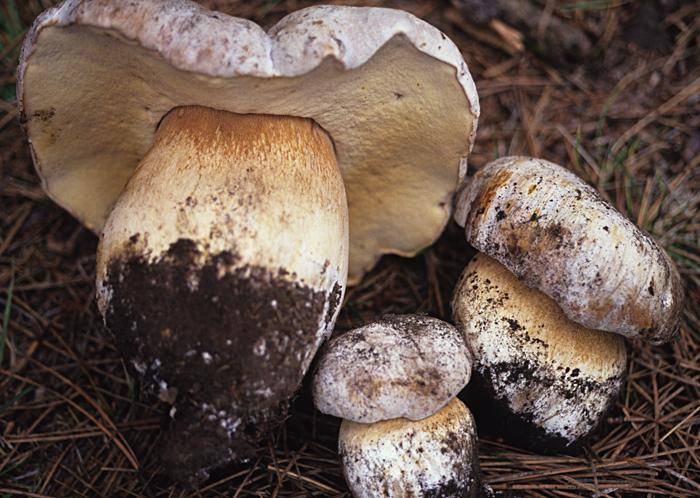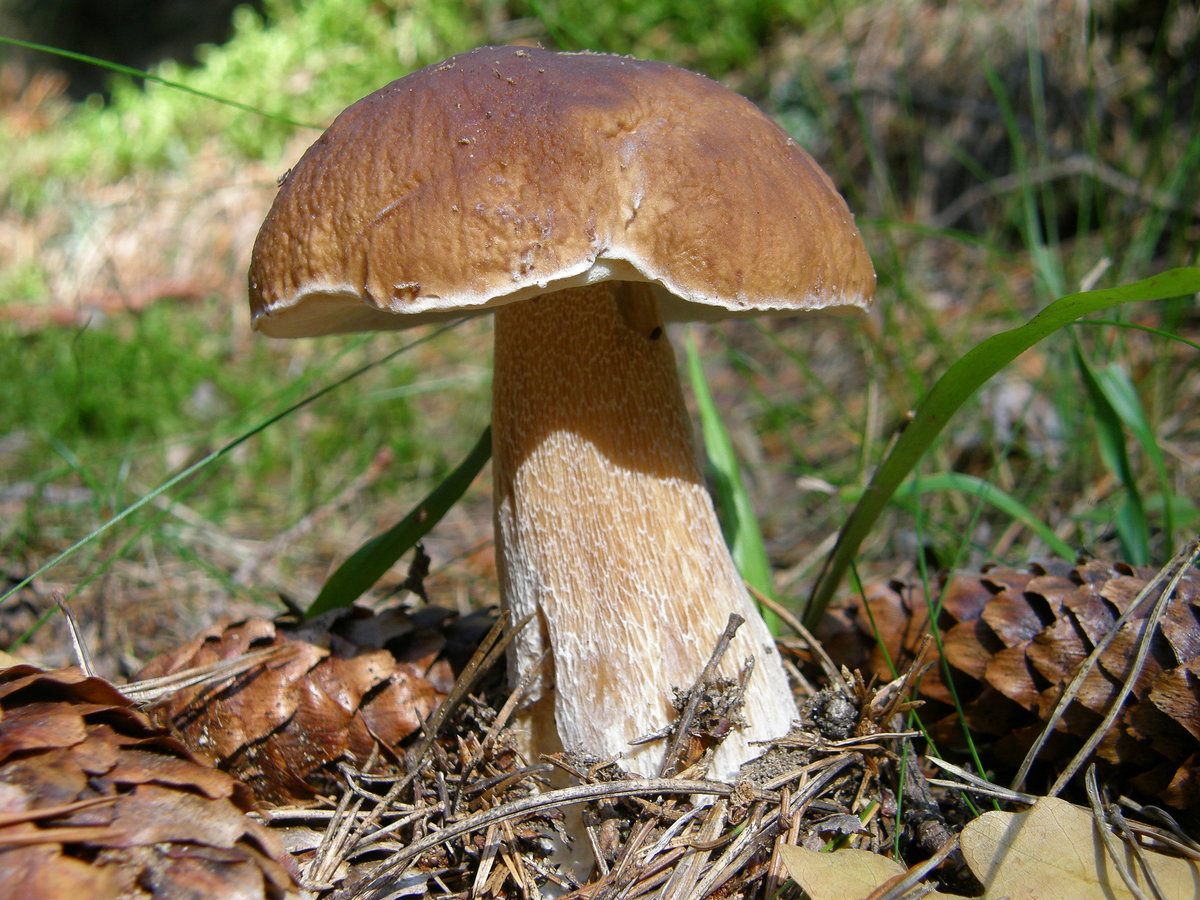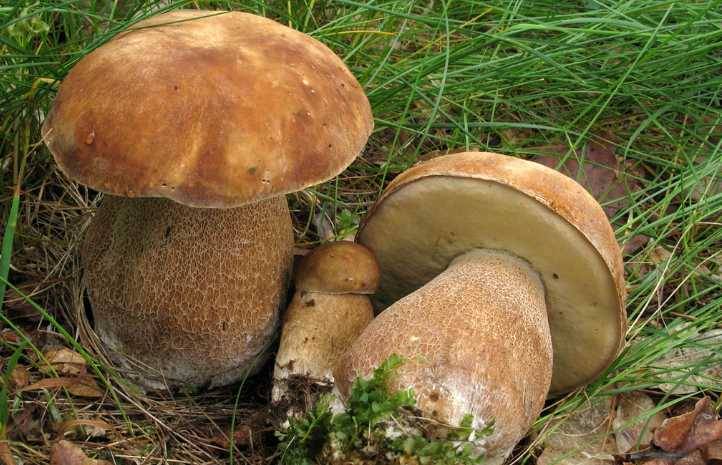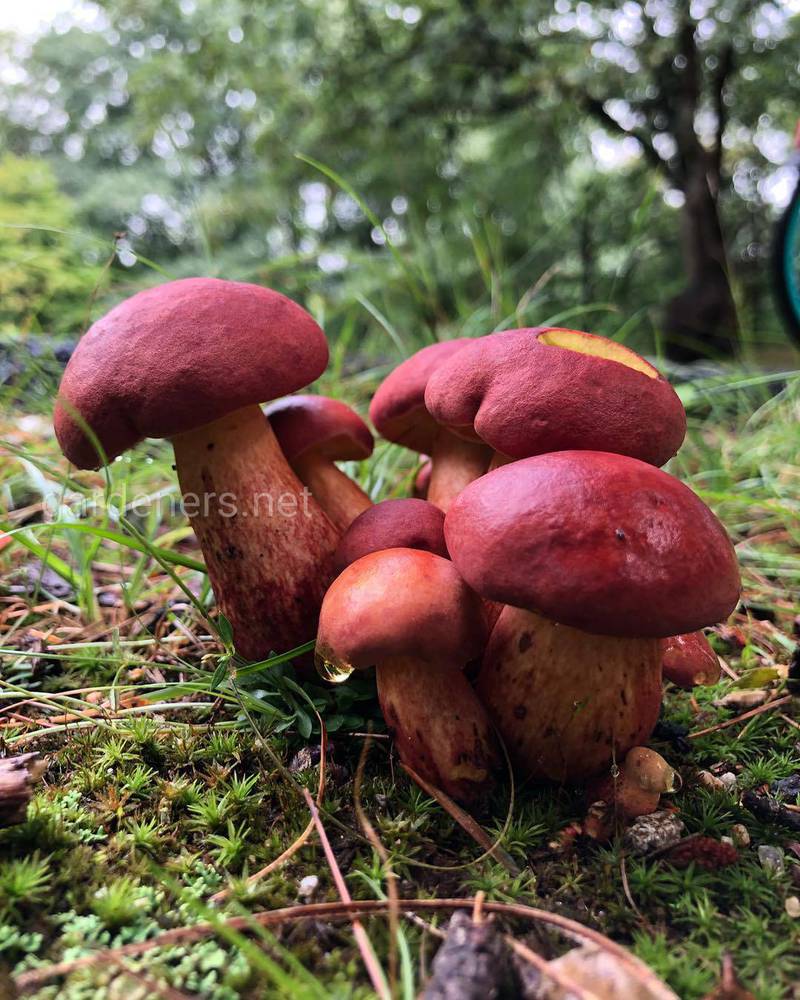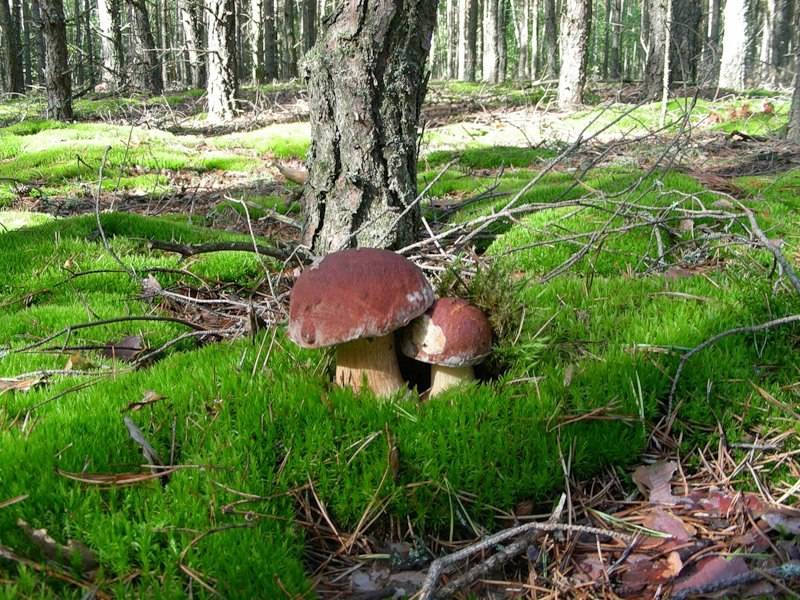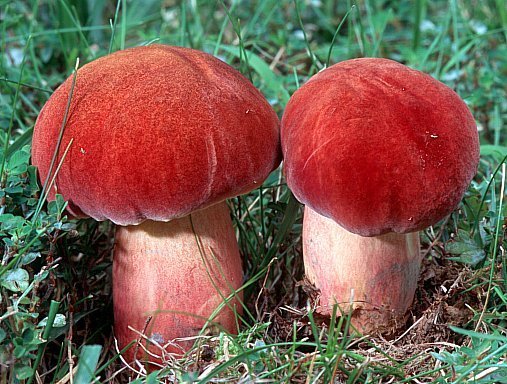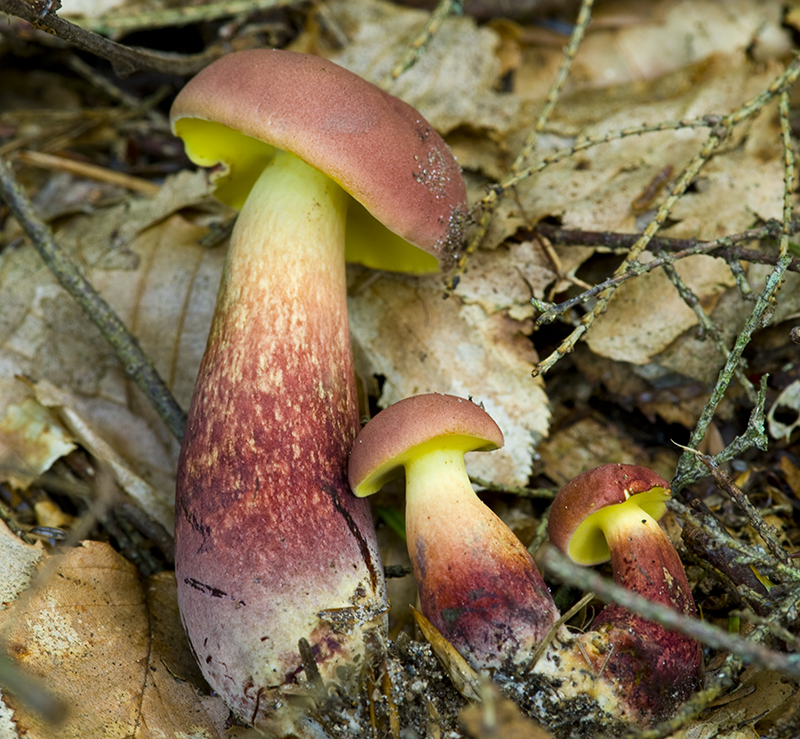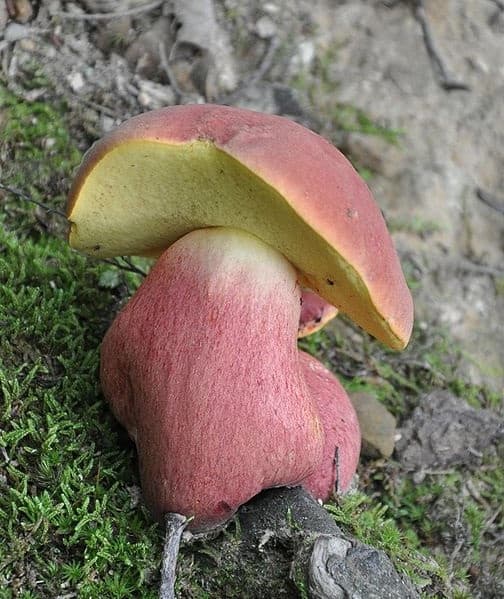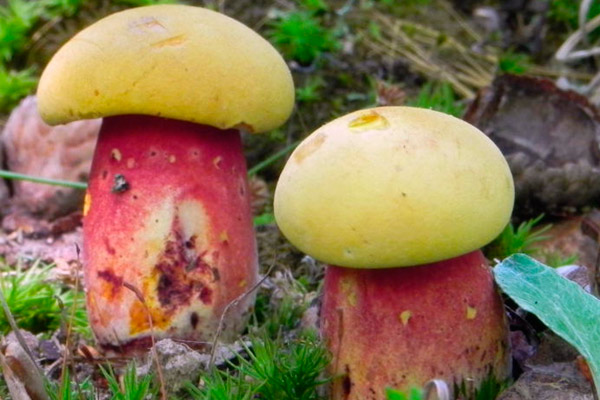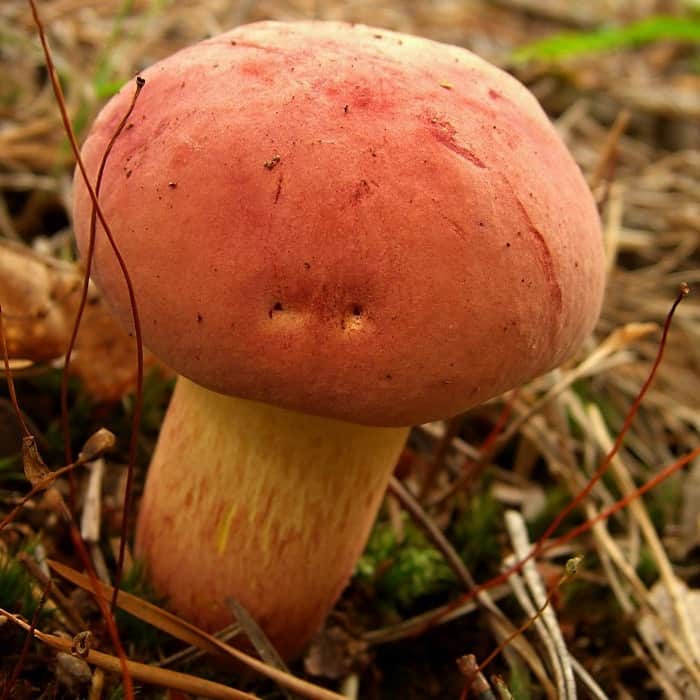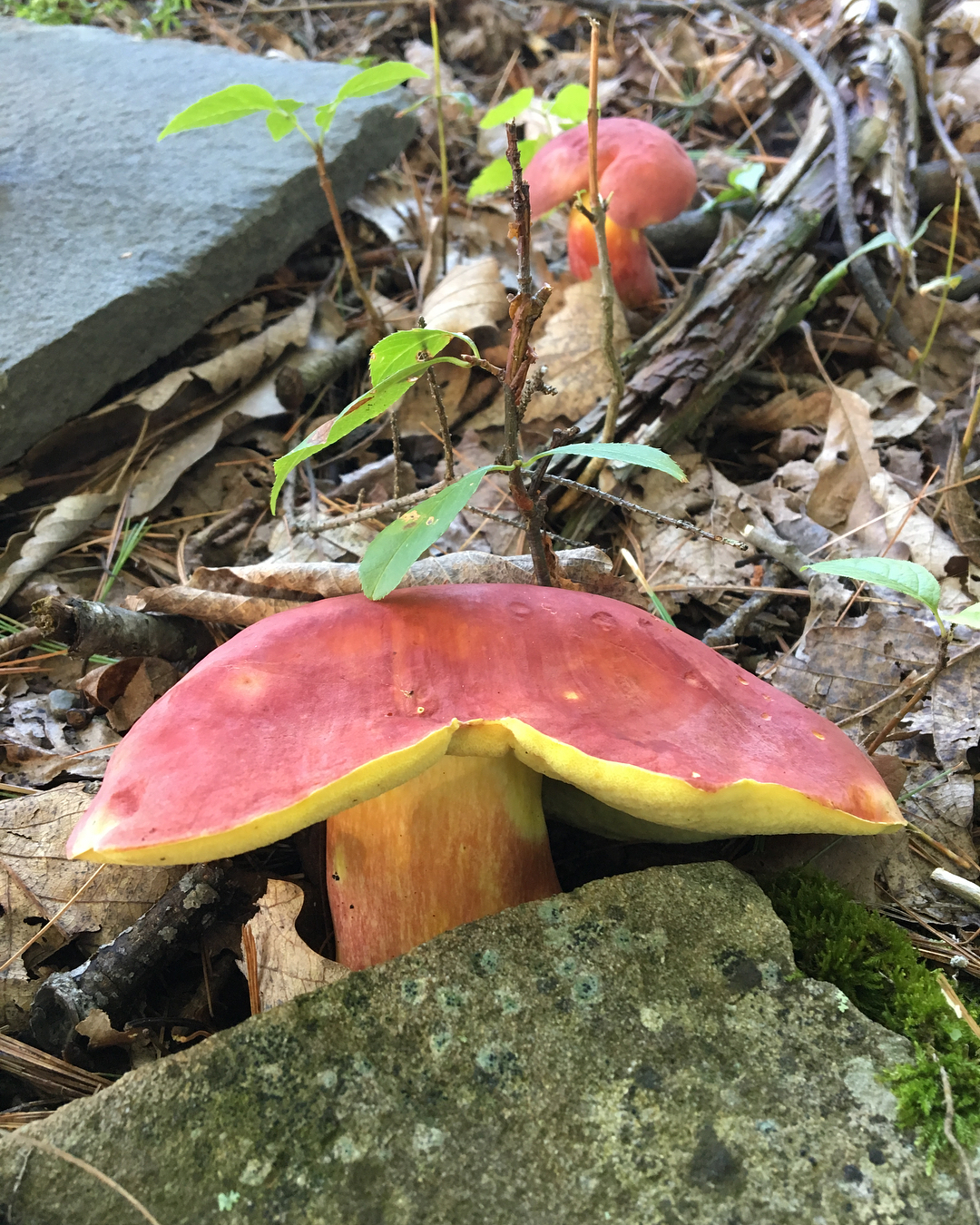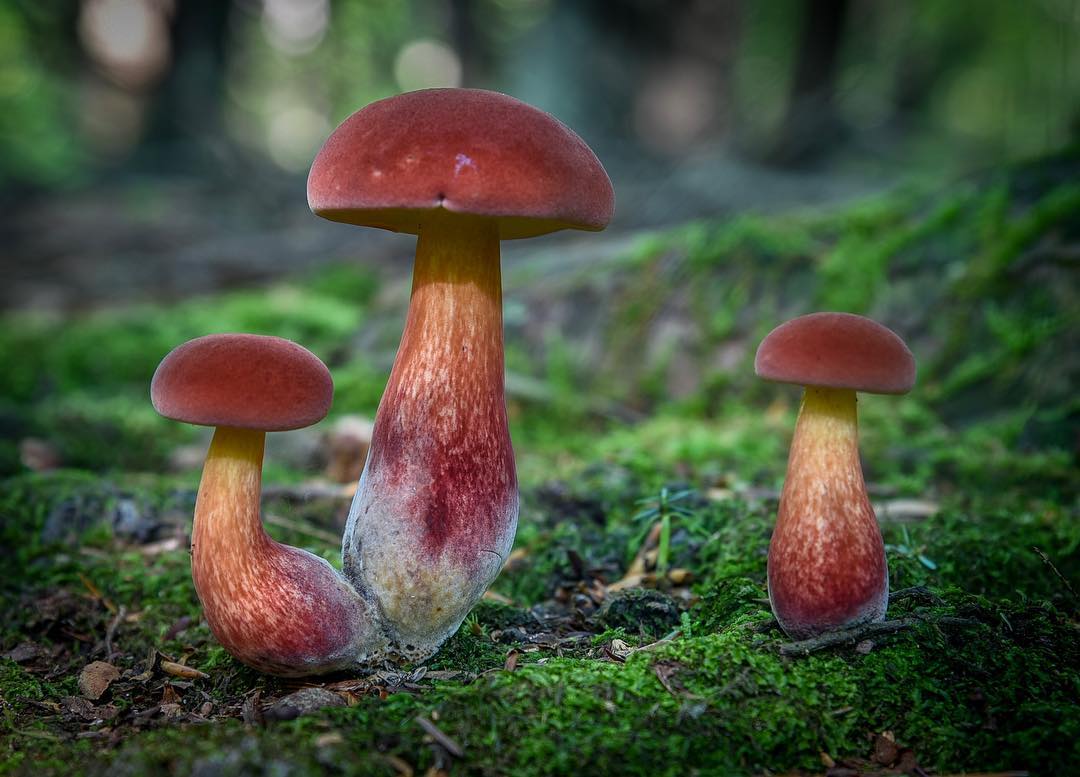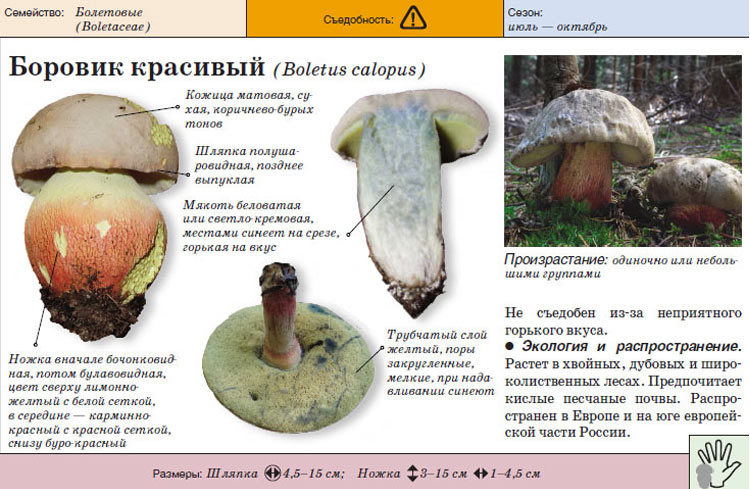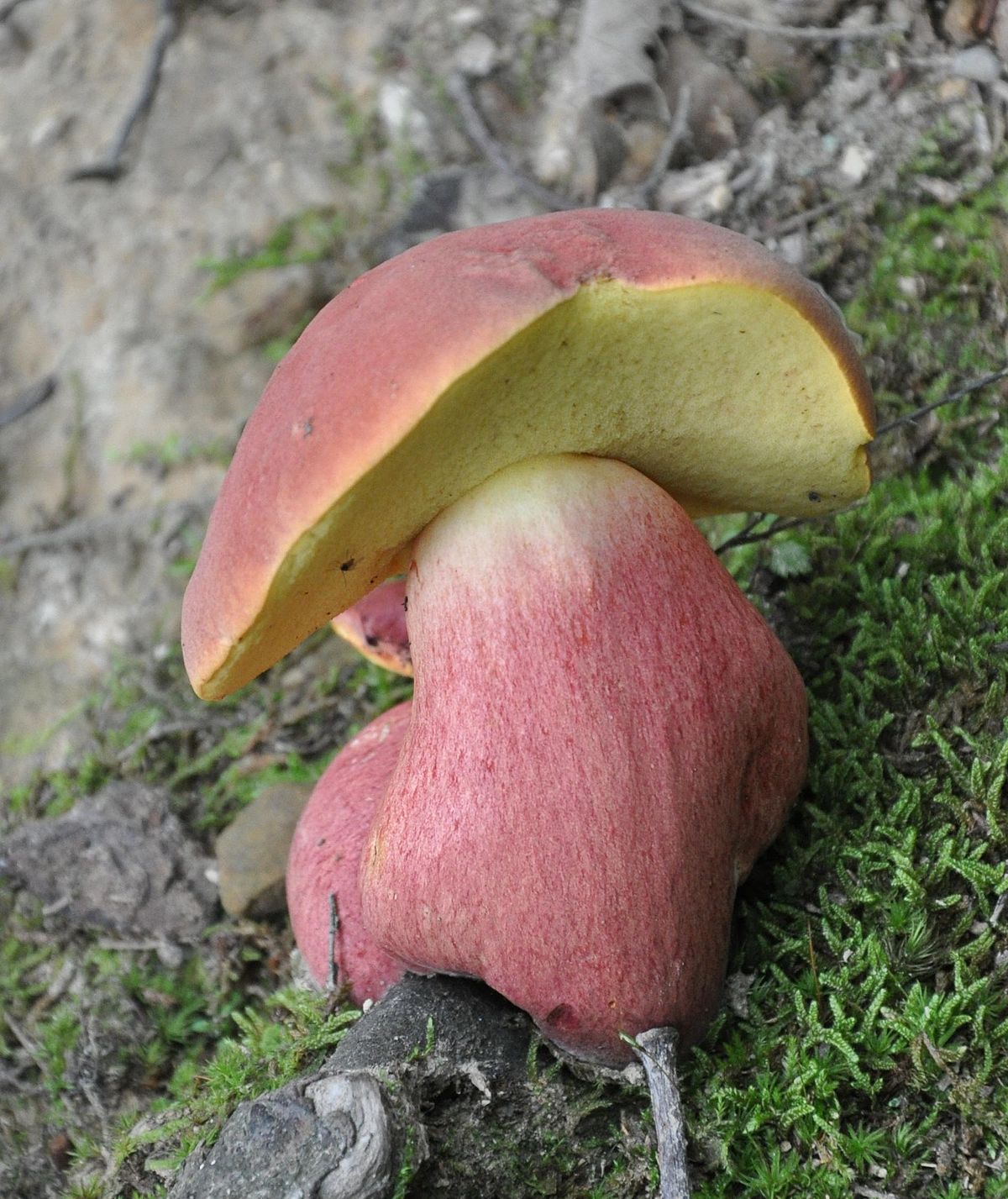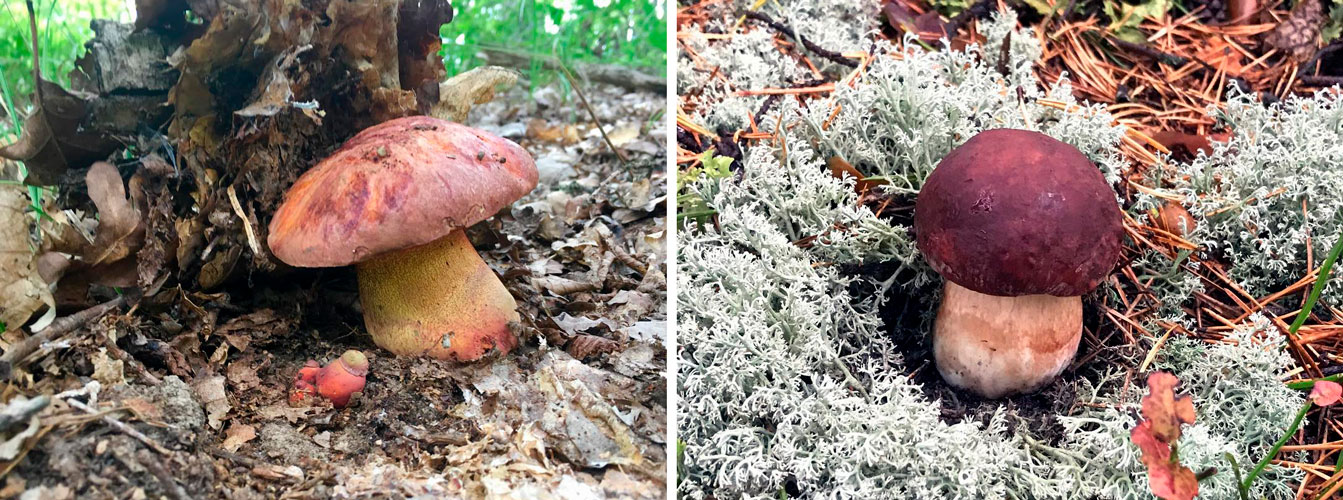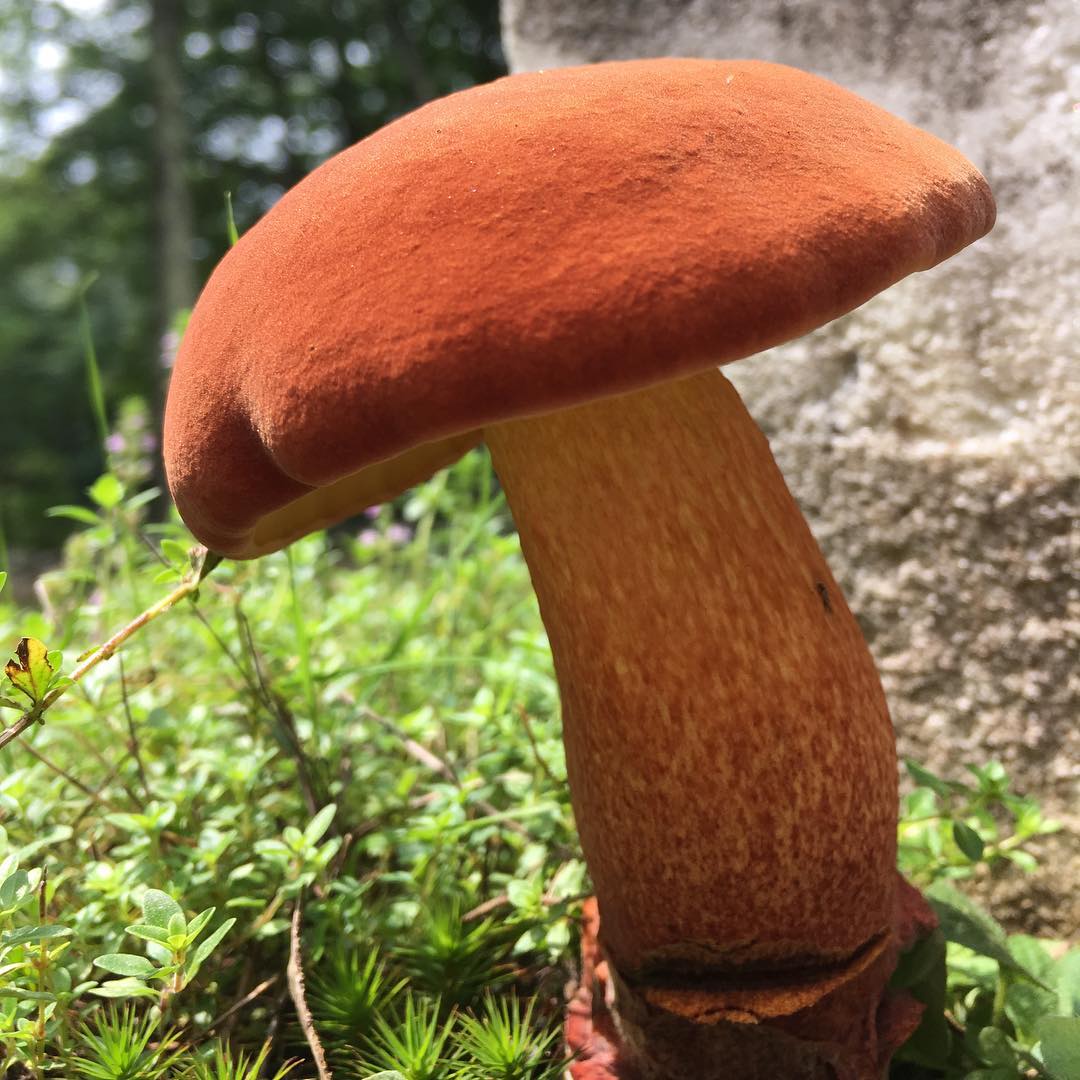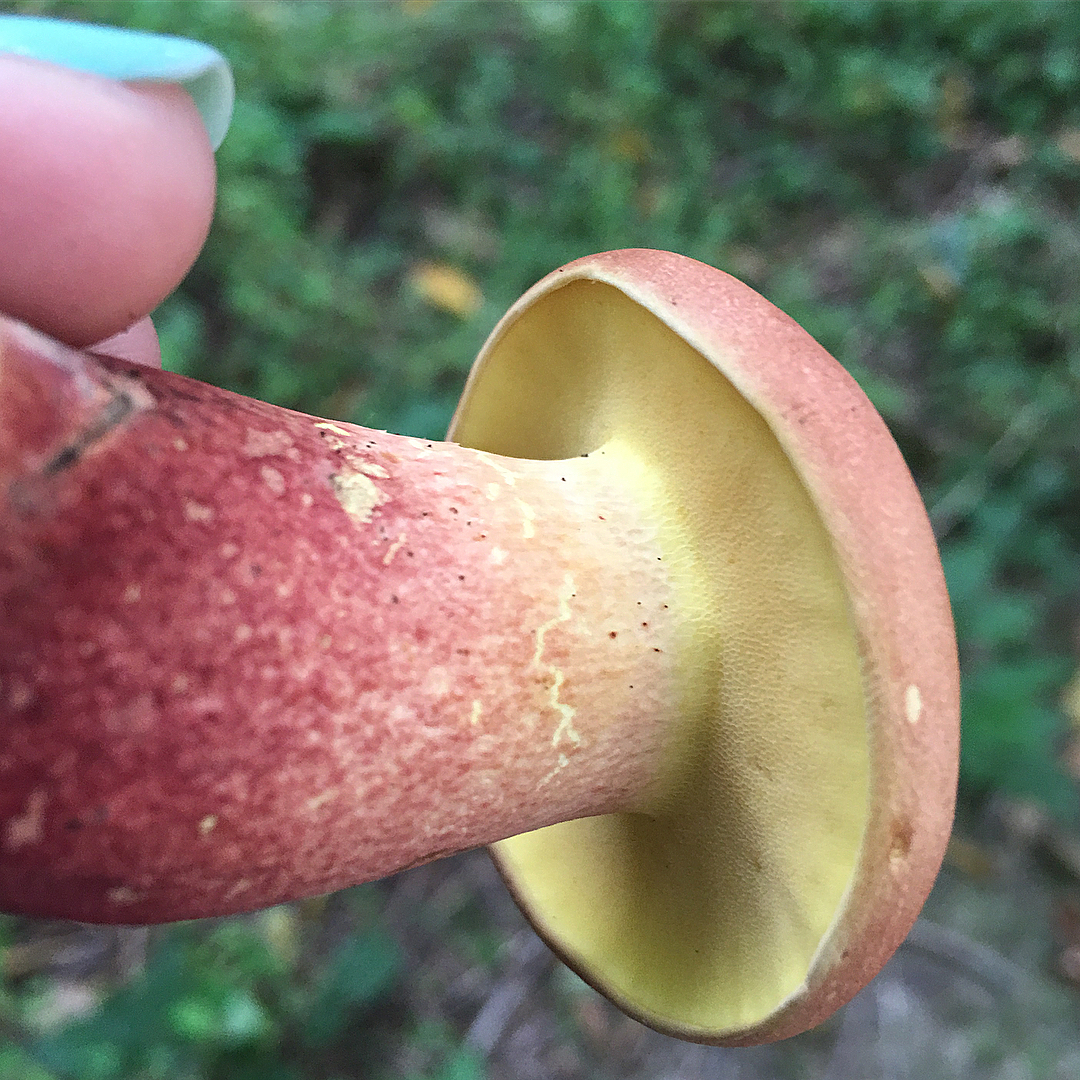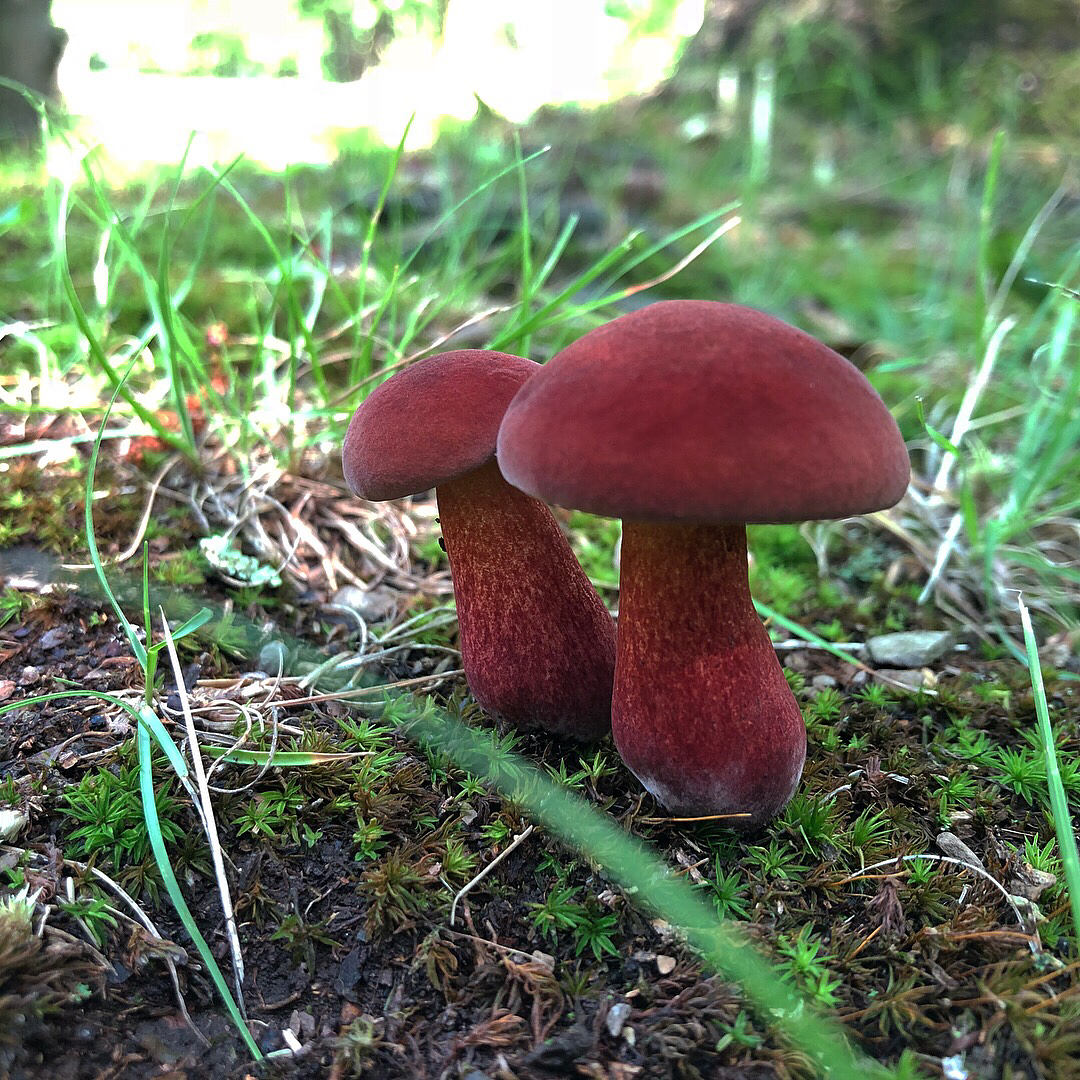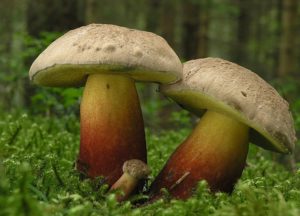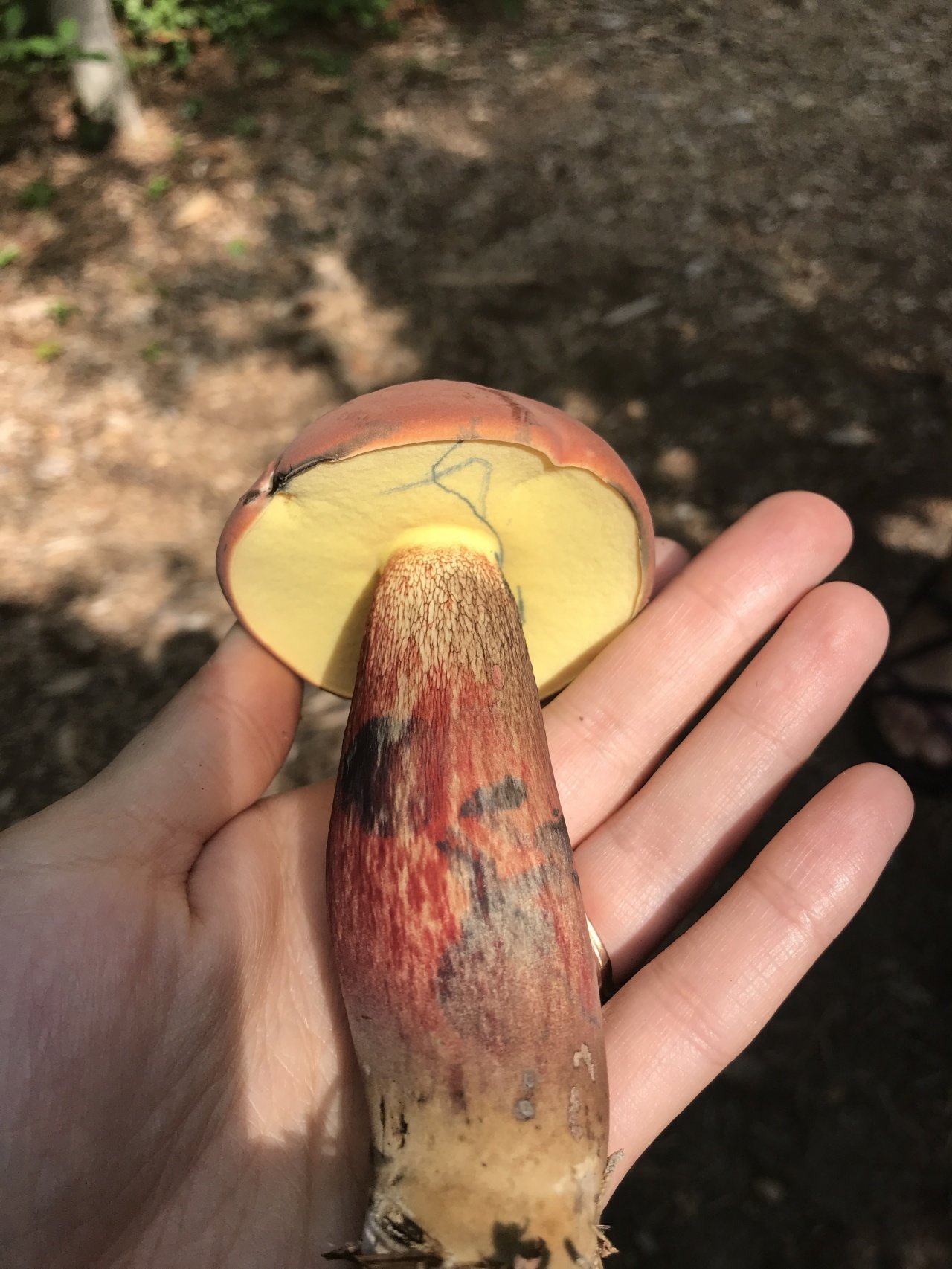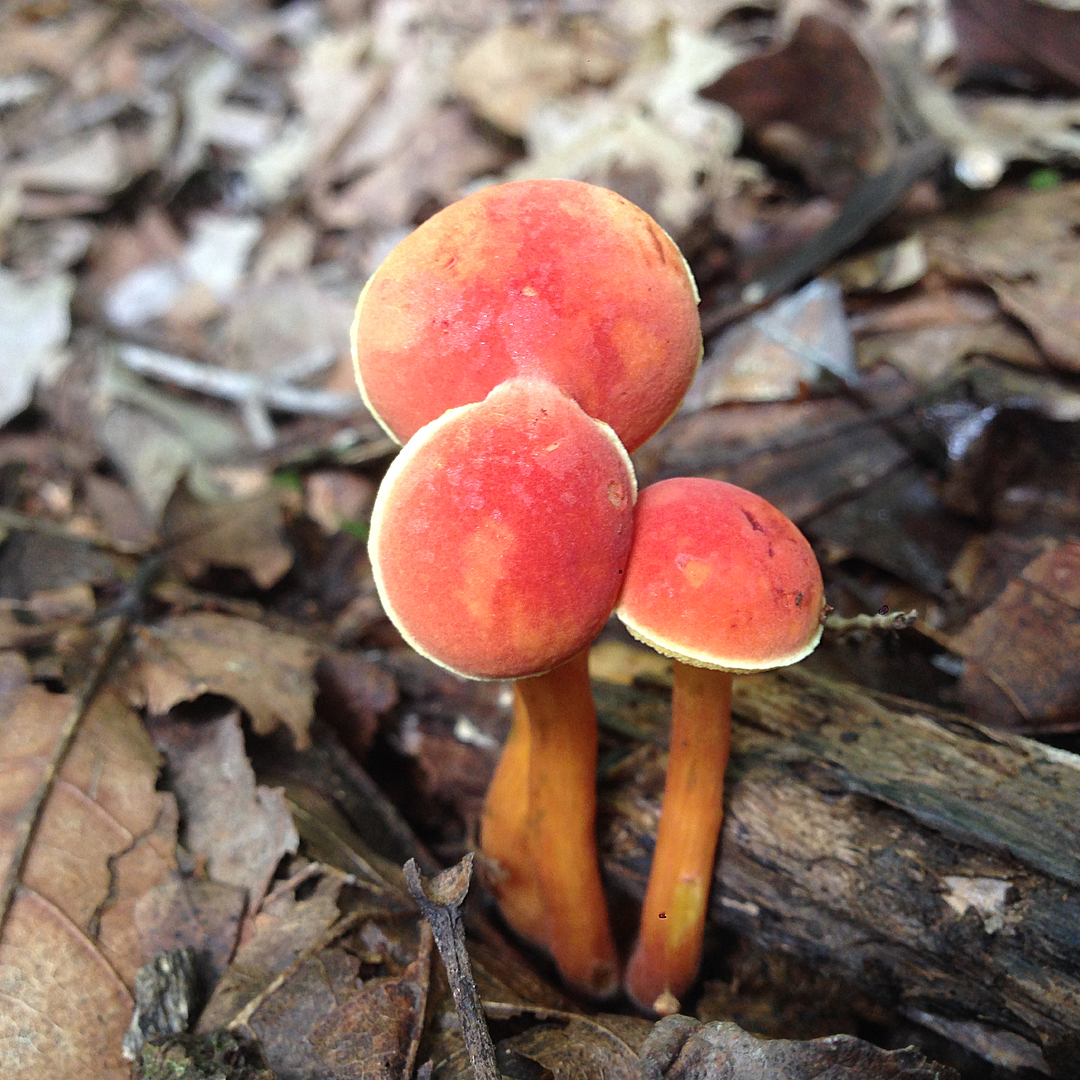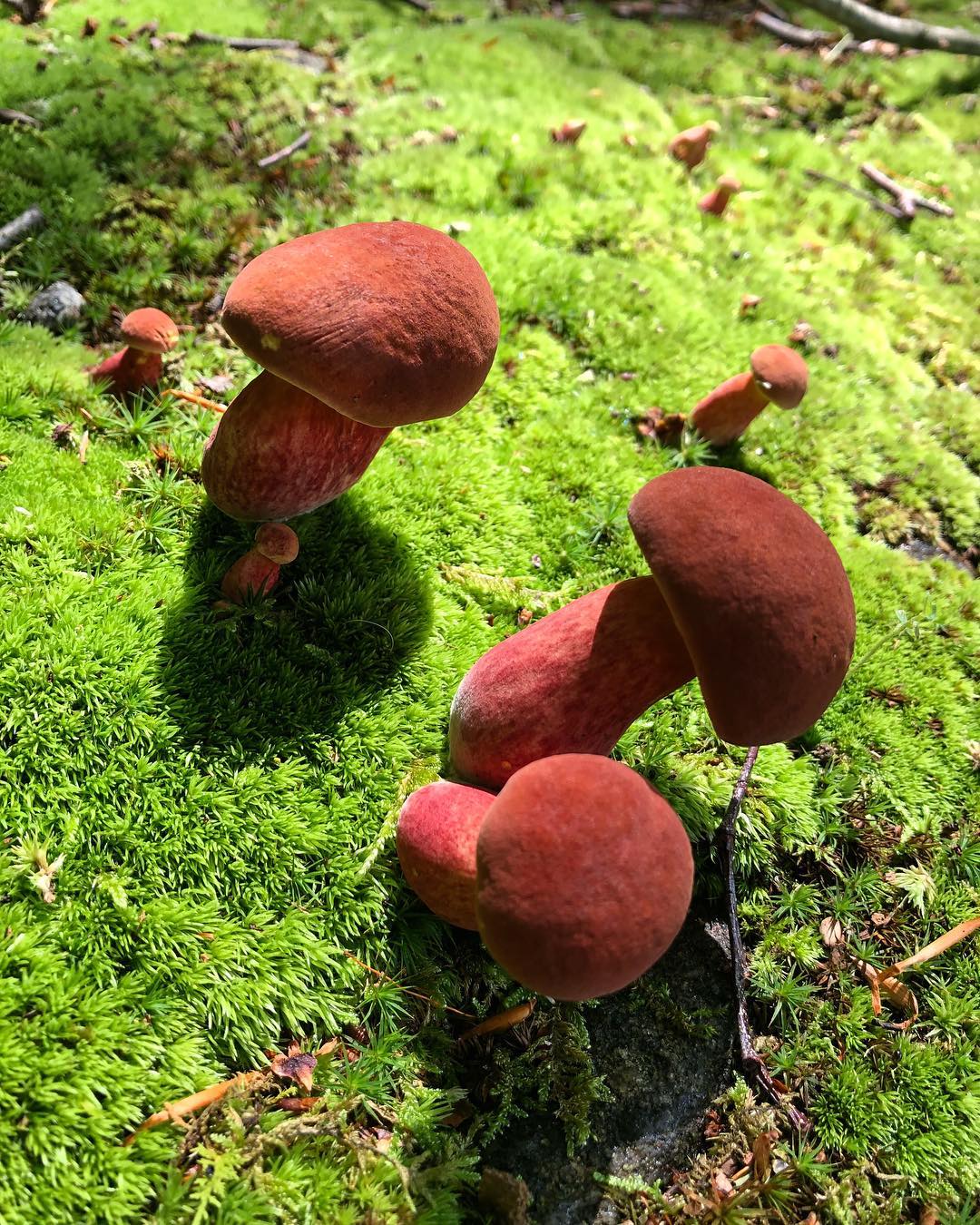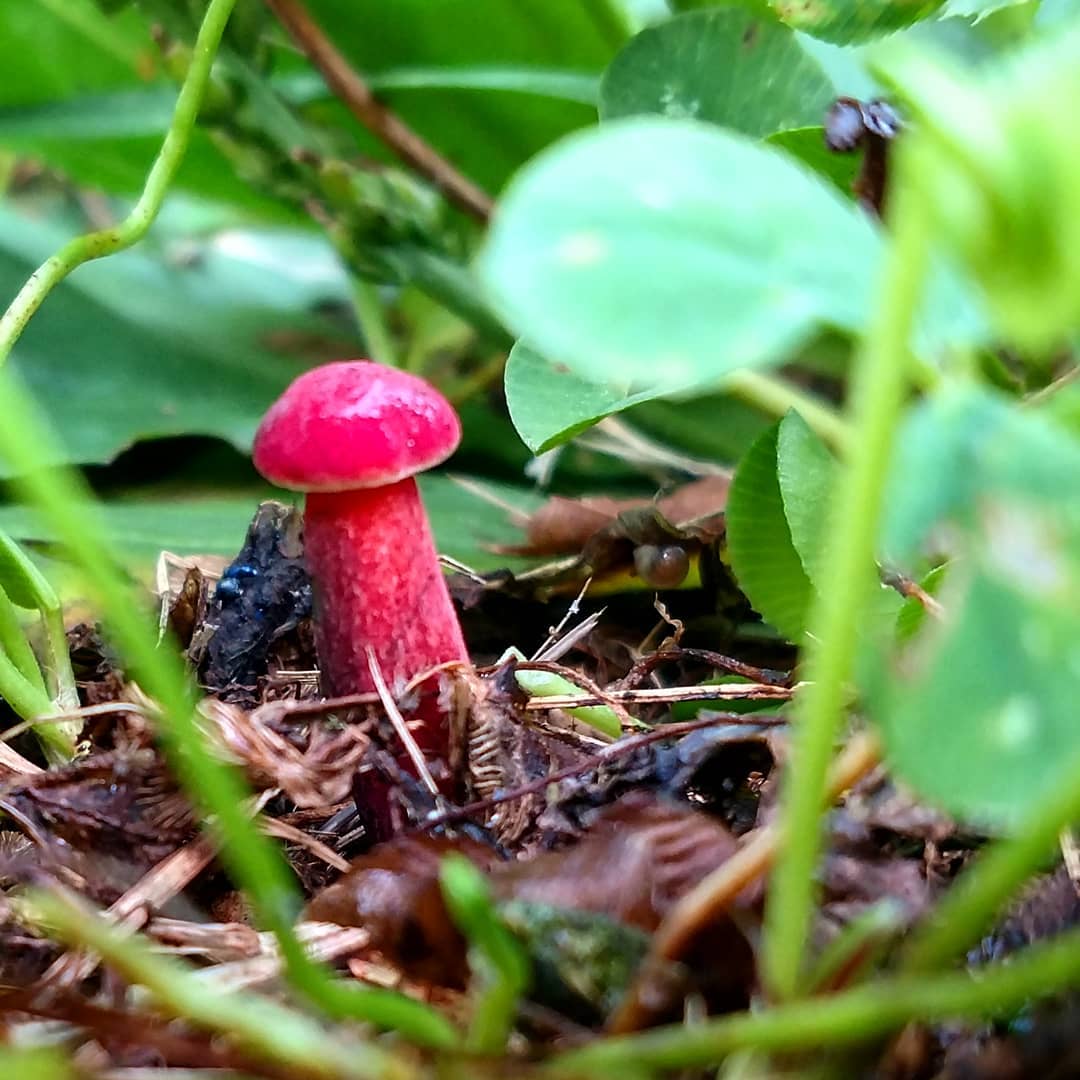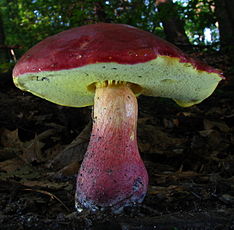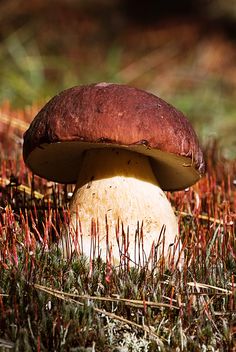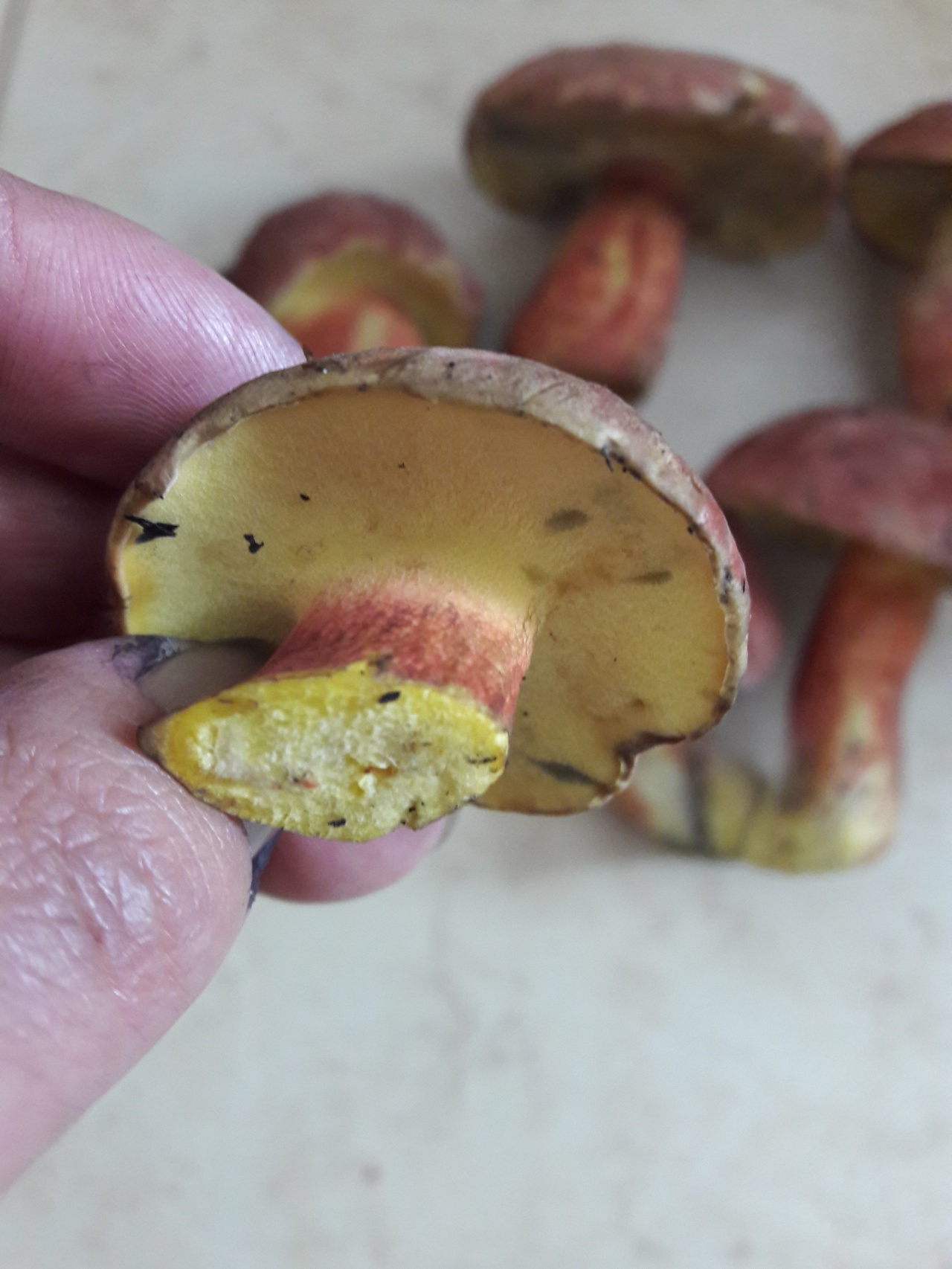When mushrooms appear
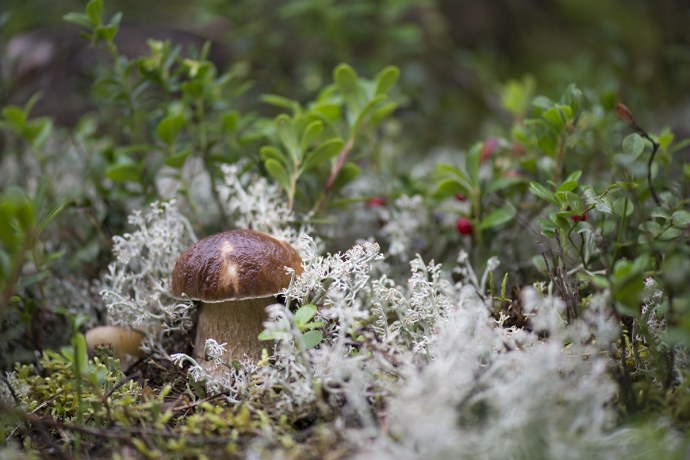
The mycelium of the fungus begins to grow from early spring to late autumn.
The boletus season is considered to be the period from the beginning of summer (in June) to the beginning of autumn (mid-September). At the same time, it is better to go to pick mushrooms after the rain.
Since the temperature and humidity of the air play a huge role in the appearance of a sufficient amount of these delicious gifts of nature, it is most likely to meet them on small sunny lawns, on the edges and abandoned paths. Since boletus mushrooms react negatively to high temperatures and lack of rain, in dry summers, one should not rely on their high yields.
Boletus mushroom girlish
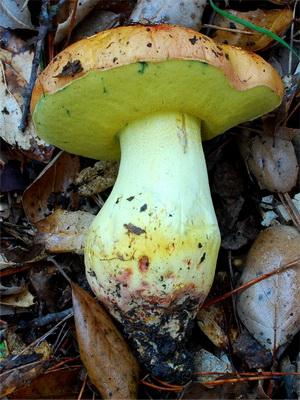

As seen in the photo, mushroom boletus girlish
(Boletus appendiculatus)
has a hat with a diameter of 7-18 cm. Its color is brownish-golden, less often with a reddish tint, almost flat, sometimes slightly convex in the center. The edges are usually slightly curved inward.
Leg (height 8-16 cm):
lighter than the cap, along the entire length with a yellowish mesh, which is practically absent in old mushrooms. The lower part is strongly pointed.
Tubular layer:
bright yellow.
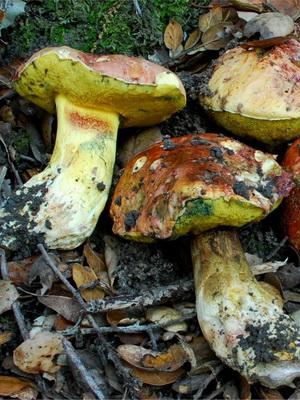

Pay attention to the photo of boletus pulp:
it is lemon-colored, when pressed or at the cut site, it turns a little blue. Very dense
Has a pleasant aroma.
Hat of the netted boletus (Boletus reticulatus) (diameter 7-25 cm):
from yellow to brownish brown. In young mushrooms, it is hemispherical, becoming convex over time. Velvety to the touch.
Leg (height 3-11 cm):
yellowish or light brown, lighter than the cap, usually with a network of small veins, but in young mushrooms it can be almost smooth. Tapering from bottom to top, thick, dense and fleshy.

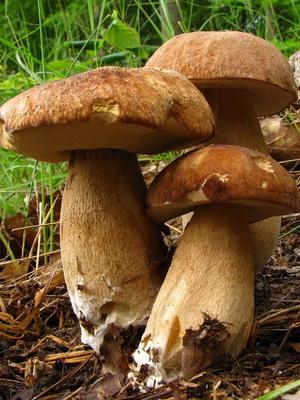
The photo of the white oak mushroom shows that its tubular layer changes color depending on the age of the mushroom from white to greenish or olive. The pores are large and rounded.
Pulp:
white, firm and very fleshy, with a sweet nutty flavor.
Doubles:
edible representatives of the Boletovye family and the gall fungus (Tylopilus felleus), which has a dark mesh on the leg, as well as a pinkish tubular layer.
When it grows:
from late May to mid-autumn in the Krasnodar Territory and the neighboring republics of Russia, as well as in the countries of the Eurasian continent with a temperate climate. Less common in North America and North Africa.
Where can I find:
on alkaline soils of deciduous forests, most often next to beeches or chestnuts, and from mushrooms - with granite-footed oak tree.
Eating:
in almost any form - boiled, fried, dried or salted.
Application in traditional medicine:
does not apply.
Other names:
white oak mushroom, white summer mushroom, boletus net.
Boletus (pain, boletus) (Boletus) is a genus of mushrooms that belong to the kingdom of mushrooms, the department of basidiomycetes, the class of agaricomycetes, the order of the boletus, the family of boletus. The name literally translates as "mushroom growing in coniferous forests." White mushroom, one of the most common species of the bolet family, is often called boletus.
Characteristic
Mushroom dimensions
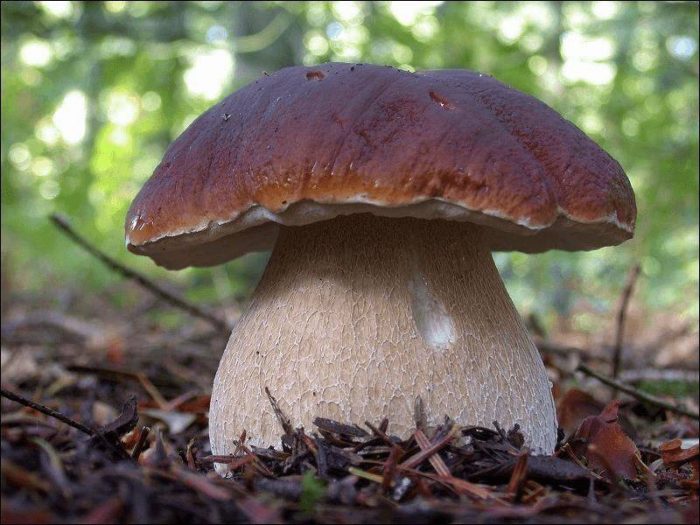
Fans of "quiet hunting" are very happy when they see a boletus in the meadow - because given that they often grow in groups and are rather large in size among other edible mushrooms, you can very quickly pick up a full basket of excellent gifts of nature. Having in their arsenal such positive qualities as sufficiently large parameters, at a more mature age they can generally reach impressive sizes and gain up to 1 kg of weight.
Hat
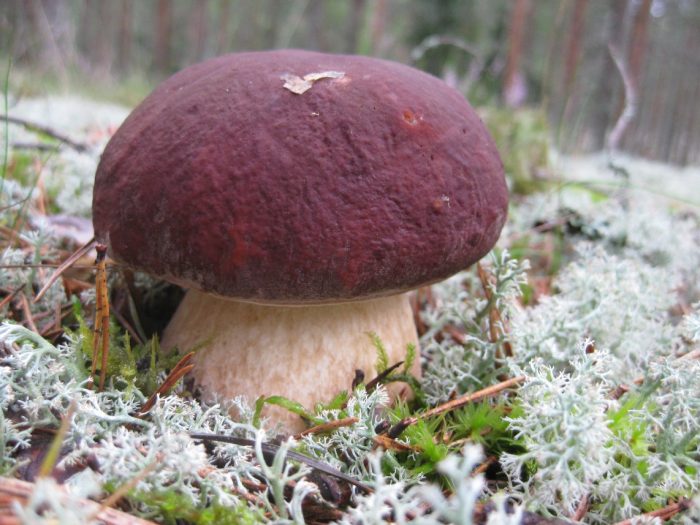
- Advertising -
The color of the cap varies from white and light yellow to dark brown, almost black, depending on the species of boletus, of which there are a huge number in nature.With regard to the size of the cap, it also has a wide range - on average, from 5 to 25 cm in diameter. Boletus belongs to the cap mushrooms and has light white, yellow and even reddish pores, and all shades of brown are characteristic of the spore powder. The shape of the cap is rounded, while it can have both a pillow-shaped and a flat appearance. By tactile sensations - dry, both velvety, and absolutely smooth to the touch.
Pulp
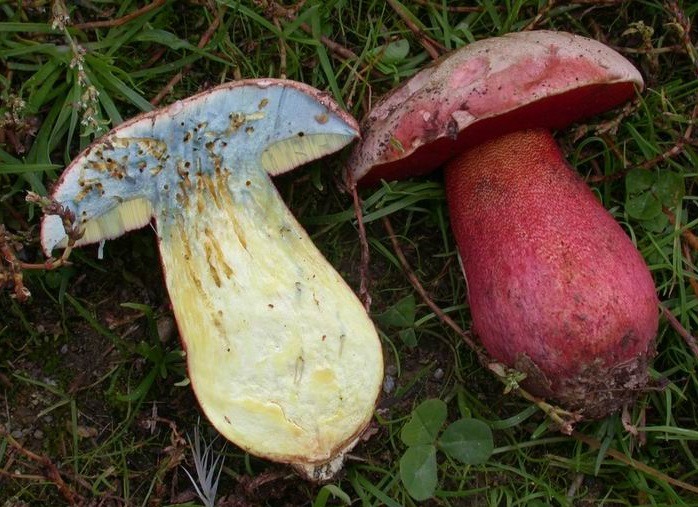
The pulp of boletus is white or light yellow, lemon shade. In most species, the cut turns blue, in some, the color remains unchanged or turns red.
Leg
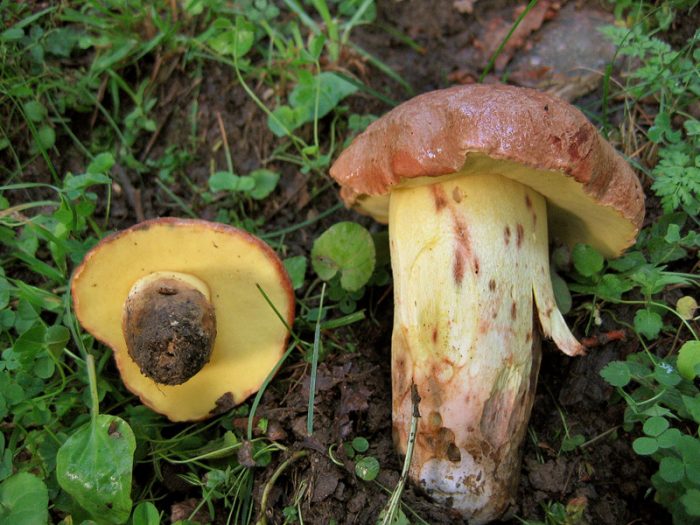
- Advertising -
The size of the mushroom leg is also directly dependent on the subspecies - but, in general, the average indicator is 3-18 cm.White, yellowish, brown and reddish - it is always quite massive and has a specific thickening at the base or middle part of the boletus leg. It is sometimes even and smooth to the touch, but, in most cases, the stem has a mesh or fibrous surface.
Description of boletus bicolor
The cap of the mushroom in the process of maturation changes from convex to more open. The hat is covered with a rich pink-red skin. The stem of the fruiting body, like the cap, is pink-red.
The mushroom pulp is yellow; at the cut site, it acquires a bluish tint. A tubular layer is hidden under the cap. The color of the tubes is yellow.
Places of distribution of boletus bicolor
The most common boletus bicolor in North America. The peak of fruiting occurs in the warm season, that is, in the summer months. They grow in deciduous and coniferous forests.

Taste qualities of boletus bicolor
Boletus has nutritional value, it gives a nutty flavor to dishes. Bicolor boletus broths are much more nutritious than meat broths. The energy value of dried boletus is two times higher than that of chicken eggs.
Two-colored boletus mushrooms are suitable for all types of culinary processing: they can be boiled, fried, stewed and pickled. With the help of these mushrooms, you can easily diversify the table.
Growing methods
The main characteristic feature of eringa is its resistance to viruses and bacterial lesions. In addition, this species tolerates storage and transportation well, while it does not lose its taste and appearance at all.
It is very important that the cultivation technology is very simple and is much cheaper than, for example, the cultivation of mushrooms. For self-cultivation, it is necessary to prepare the substrate
Most often, a log or a deciduous tree stump is chosen. Better if it is birch, aspen or alder. You will also need a drill and packing mycelium. First, you need to inspect the selected tree for damage by rot or other fungi. The thickness of the log should not exceed 30 cm, and its length can be 35-50 cm.
Under natural conditions, the cultivation of eringa on wood should be started at the end of April-May, when stable warm weather is established. Indoors, these mushrooms can be grown all year round, provided they are heated during the cold season. The optimum temperature is between 10 and 27 degrees.

Before planting, the prepared wood must be soaked for several days so that the tree is thoroughly saturated with moisture. Then the tree is taken out and, for several hours, excess liquid is allowed to drain. There is no need to leave it for a longer period or put it out in the sun, it can dry out. In the prepared substrate, a drill makes several holes with a depth of 4 to 10 cm and a diameter of no more than 1 cm. In order not to introduce mold or bacteria into the mycelium, wash your hands thoroughly and wear gloves. Then the mycelium is neatly placed in all the pre-drilled holes
Further, they are carefully plugged with wax or covered with wooden corks.
To speed up the germination process, the wood is covered with a bag or coarse cloth.The prepared log with mycelium is removed to a dark, well-ventilated place. The moisture content of the substrate must be maintained at a high level. When grown in natural conditions, it is necessary to moisten not only the wood, but also the earth around it. With the right actions, the substrate will soon be covered with white mycelium. And in about 3-5 months the first harvest of mushrooms will appear.
- In the absence of space or the impossibility of using logs, there is an opportunity to grow royal oyster mushrooms in your garden or at home. Any room is suitable for this: a garage, a barn, a cellar or a basement. Any containers can be used as a substrate: plastic bottles, cans, boxes and even plastic bags. It is only necessary to carefully and correctly sow the mycelium and observe some conditions:
- The temperature should be between + 16 ° C and + 27 ° C.
- Air humidity not lower than 90%.
- When fruiting begins, you should take care of the lighting.
Further, special care will not be needed, since these representatives of the mushroom kingdom are completely unpretentious.
Useful properties and restrictions to use
The boletus contains a lot of elements useful for the human body:
- vitamins A, B1, C, D;
- calcium;
- iron.
The beneficial properties of mushrooms are widely used by both traditional and folk medicine. In traditional medicine, the components of boletus are included in the formulations of the following products:
- strengthening the joints;
- prevention of osteoporosis;
- treating anemia;
- maintaining the heart muscle;
- an increase in the level of hemoglobin in the blood;
- strengthening the immune system;
- preventing the deposition of cholesterol.
Description of the mushroom
Boletus contains elements that are used as antibiotic substances in the fight against E. coli and some forms of tuberculosis. Cosmetologists use riboflavin, which mushrooms are rich in. This substance stimulates the growth of hair and nails.
In folk medicine, boletus has long been applied to frostbitten parts of the body. Also, tinctures of these mushrooms treat sleep disorders and relieve nervous excitement.
Note!
Mushrooms should be consumed in moderation by people with chronic liver, kidney and gastrointestinal diseases. The product should not be eaten during pregnancy, lactation and children under the age of three.
Useful properties of boletus
Forest boletus is a natural and widely available storehouse of essential vitamins and many beneficial properties. The composition of the mushroom pulp is presented:
- thiamine;
- riboflavin;
- pantothenic acid;
- pyridoxine;
- folates;
- ascorbic acid;
- alpha tocopherol;
- vitamin PP;
- niacin;
- potassium;
- calcium;
- magnesium;
- sodium;
- gray;
- phosphorus;
- chlorine;
- iron;
- cobalt;
- manganese;
- rubidium;
- fluorine;
- chrome;
- zinc.
Useful properties are also due to the presence in the composition of a sufficiently large amount of digestible carbohydrates, essential and nonessential amino acids, which are involved in metabolic processes, oxidative and reduction reactions occurring in the human body. Vitamins "A", "B1", "C" and "D" promote the growth of nails and hair, and minerals are necessary for bones and joints, to prevent osteoporosis and anemia, to maintain normal functioning of the heart muscle.
We also recommend reading:
We collect and eat green mushrooms Varieties of ryadovka mushrooms: photo and description Where to pick mushrooms: Krasnodar Territory is a great place for quiet hunting Unique Crimean mushrooms
general information
The origin of its name is boletus, like many of its other brethren (for example, boletus and aspen), owes to its habitat. That is why this mushroom is called so because it can be found most often and in large quantities in pine forests.
Boletus are edible mushrooms and are awarded the first and second degree of nutritional value.In addition, with their pleasant taste, they have conquered mushroom pickers since ancient times, and skillful housewives have appreciated many methods of their preparation.
- Advertising -
Boletus (or boletus) belongs to the class of Agaricomycetes, the boletus genus and the Boletaceae family.
Growing at home

Growing boletus can have excellent results if you approach this business with all responsibility and diligence. Due to the fact that the boletus grow most favorably under a birch, spruce or pine, with which they form mycorrhiza, before starting to grow mushrooms, it is necessary to plant such trees on a plot of land allocated for this.
There are three ways to achieve great results and delight yourself with the delicious gifts of nature:
- It is necessary, first of all, to select healthy boletus, without worms and damage, and then chop them thoroughly and soak for 24 hours in clean water. After these manipulations, they must be mixed and filtered. The resulting infusion, which now contains fungal spores, is carefully poured under the above trees.
- The second method is more complicated, because for its implementation, ready-made land plots with mycelium are used, which are dug out in the forest. Upon arrival home, such a mycelium is placed under the trees in a specially designated place, where shallow pits are first made for the mycelium, which are then covered with forest soil from above. The absence of direct sunlight and moderate watering is the key to success in growing boletus.
- The third method involves placing caps of overripe mushrooms under the trees, pre-cut into small pieces and mixed with damp earth.
Observing all the subtleties of correct and regular watering, already next year you can harvest the first crop, which at first will consist of single boletus, which, in the future, will certainly acquire families.
Harm and contraindications
The pulp of these mushrooms contains chitin, which is practically not absorbed by the human body. And this substance is destroyed only under the influence of high temperatures. Therefore, oyster mushrooms must be cooked. In order for them to be beneficial, it is recommended to use them in food no more than 2 times a week.
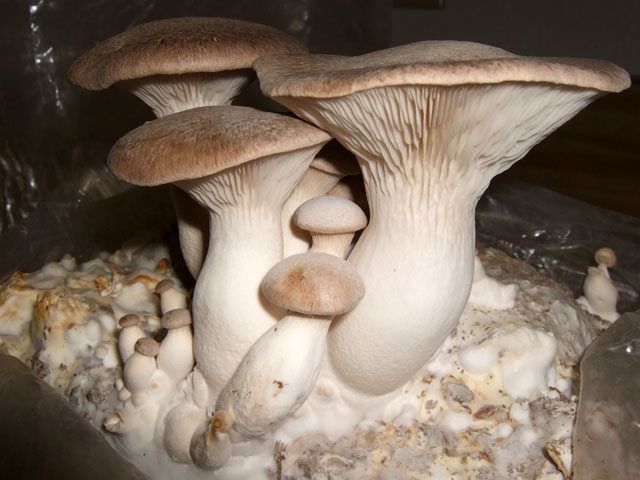
Experts advise against giving mushrooms to children under five.
They should be eaten by adolescents with great care and in small quantities. This also applies to the elderly.
For problems with the liver, gastrointestinal tract, kidneys and pancreas, it is worth limiting the amount of the product consumed.
Care should be taken when collecting and preparing for people susceptible to allergic reactions
Since the semen of eringa, if inhaled, can cause allergies.
Dangerous resemblance
When collecting boletus bicolor, it is necessary to pay attention to the fact that they have poisonous twin brothers - pink-skinned boletus. The main difference between the pink-skinned boletus is the less saturated color of the cap

The diameter of the pink-skinned boletus cap is 7-20 centimeters. At first, the shape of the cap is hemispherical, but over time it opens and becomes cushion-shaped, and later becomes prostrate with a depressed center. The skin of the cap is smooth or slightly velvety. The color of the cap is dirty yellow or gray with a reddish bloom. The flesh is quite firm and the stem may be softer. The leg is lemon-yellow, and at the base it is wine-red, it turns blue on the cut. Its height can reach 20 centimeters.
Although pink-colored boletus are rare, there are cases of poisoning with these particular mushrooms. Pink-skinned boletus is poisonous not only raw, but also after boiling. A few hours after eating mushrooms, symptoms of poisoning appear: diarrhea, vomiting, fever.
When eating a large number of poisonous mushrooms, convulsions and loss of consciousness occur.No deaths have been reported, but sometimes serious complications can occur, especially children and the elderly are at risk. Therefore, you should be extremely careful when collecting boletus.

Other edible boletus
• Boletus Fechtner has a hat with a diameter of 5-15 centimeters of a silvery-white color and a yellowish leg with a red-brown tint, 4-15 centimeters long and 2-6 centimeters in diameter. These boletus grow in the Far East and the Caucasus;
• Porcine boletus has a cap with a diameter of up to 8 centimeters, gray-brown and dark brown with whitish cracks, from which a net pattern is obtained. The stem of the mushroom is gray-brown. These mushrooms grow in coniferous and mixed forests;
• Boletus yellow is characterized by a yellow-brown hat with a diameter of 4-16 centimeters and a tuberous stem 4-12 centimeters high and 2.5-6 centimeters thick to match the cap. These mushrooms are widespread in Western Europe, and in our country they are seen only in the Ussuriysk region;
• Burroughs boletus has a cap measuring 7 to 25 centimeters from whitish to gray or yellow-brown color and a leg 10-25 centimeters long and 2-4 centimeters thick whitish in color. These mushrooms grow in the forests of North America.



